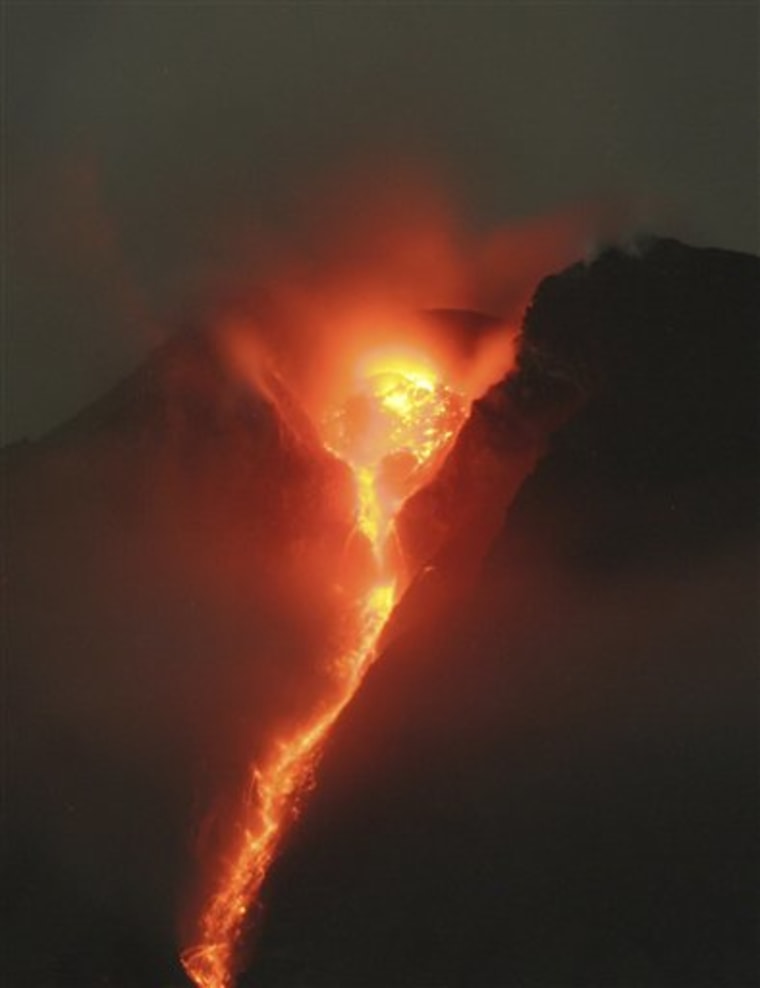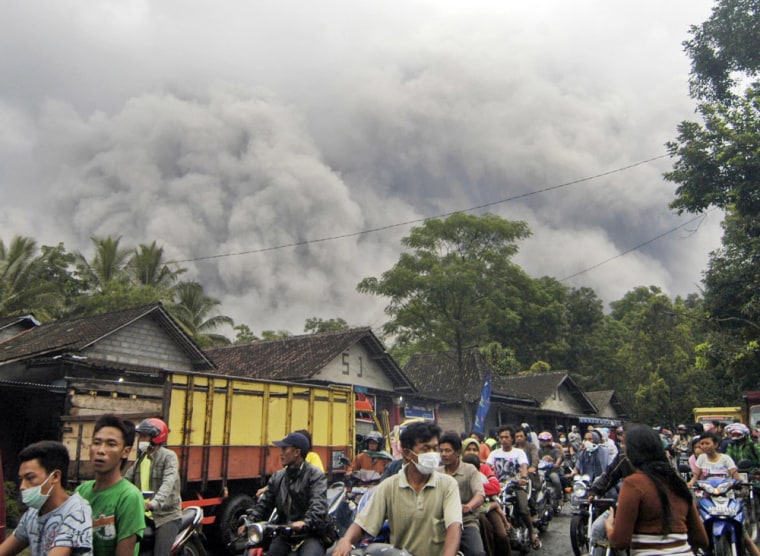A deadly Indonesian volcano spewing lava and smoke for more than a week erupted Wednesday with its biggest blast yet, shooting searing ash miles into the air as soldiers hastily evacuated villages and emergency shelters.
Women screamed and children cried as they were loaded into trucks while rocks and debris rained from the sky. Several abandoned homes were set ablaze and the carcasses of incinerated cattle littered the scorched slopes.
No new casualties were reported immediately after the booming explosion, which lasted more than an hour.
"This is an extraordinary eruption, triple from the first" on Oct. 26, Surono, a state volcanologist, said.
More than 70,000 villagers have been evacuated from the 9,700-foot Mount Merapi's once-fertile slopes since it began erupting just over a week ago, killing 38 people and injuring dozens, most with severe burns.
Almost all have packed into crowded camps well away from the base.
Djarot Nugroho, the head of Central Java's disaster management agency, said funding for the refugees would run out in five days unless a national disaster was declared.
There have been more than a dozen strong blasts in recent days — including a smaller one Wednesday morning — prompting some scientists earlier to say pressure building up behind a magma dome in the crater was slowly easing.
By nightfall, however, all bets were off.
"We have no idea what's happening now," said Surono, a state volcanologist and among those who had been predicting a drop in activity. "It looks like we may be entering an even worse stage now. ... It's up to Merapi from here."
The danger zone was widened from six miles to nine (10 kilometers to 15) from the glowing crater because of the heightened threat. Soldiers and police blocked all roads leading up the mountain, shooing away television crews and reporters.
"I (didn't) think of anything else except to save my wife and son. We left my house and everything," said Tentrem Wahono, 50, who lives in Kaliurang village, about six miles (10 kilometers) from the peak.
"I (didn't) think of anything else except to save my wife and son. We left my house and everything," said Tentrem Wahono, 50, who lives in Kaliurang village, about six miles from the peak.

He and his family fled on a motorbike, "racing with the explosive sounds as the searing ash chased us from behind."
Authorities were forced to move refugee shelters further away from the volcano, near Yogyakarta on Java island, Surono said.
"This is the first time that the eruption has continued for more than an hour, so I decided to move the shelters to 15 km (about nine miles) away from the summit from 10 km (about six miles) away previously," he told Metro TV. "I hope the hot clouds will not reach 10 km from the crater."
Massive explosion?There was a smaller eruption earlier Wednesday which sent gas and rocks about three miles down the mountain's slopes, Safari Dwiyono, a state volcanologist, said.
Dwiyono believes the volcano will continue to send out gas and rocks for weeks, possibly months, easing pressure building up inside the crater.
"There's no way of knowing for sure, of course," he said. "But based on what we've seen in the last few days, we're hoping there won't be a massive explosion."
The latest eruption has raised Merapi's status to "crisis" condition, said Andi Arief, a special staff at the presidential office dealing with disaster and social assistance.
Merapi, one of the world's most active volcanoes, has erupted many times in the last century, killing more than 1,400 people.
Indonesia, a vast archipelago of 235 million people, is prone to earthquakes and volcanos because it sits along the Pacific "Ring of Fire," a horseshoe-shaped string of faults that lines the Pacific.
As a reminder of that, a 6.0-magnitude quake hit waters off the eastern province of Papua on Wednesday evening, rattling several villages but causing no known damage or casualties.
At the time, U.S. Secretary of State Hillary Rodham Clinton was wrapping up a visit to Papua New Guinea — on the same island as Papua province. She was in the capital, about 1,000 miles east of the epicenter, and no shaking was felt there.
Merapi prompted the government Tuesday to order airlines to choose routes circumventing the towering dark ash on takeoff and landing.
Several international flights have been canceled.
More than 800 miles to the west, helicopters and planes were delivering aid to the most distant Mentawai islands, where last week's tsunami destroyed hundreds of homes, schools, churches and mosques.
The tsunami death toll stood at 431, the National Disaster Management Agency said.
There has been talk in recent days about abandoning villages on vulnerable coastlines and relocating further inland.
"I'm all for it," said Regen, who lives on Pagai Utara island and goes by one name. "We're all terrified now, especially at night, and wouldn't mind moving further inland."
